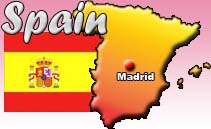Spain's gastronomy revolution turns food into art
 Madrid For the affluent gourmets dining at Spain's top restaurants, a sugar ball flavoured with smoked oak might constitute a nice little novelty.
Madrid For the affluent gourmets dining at Spain's top restaurants, a sugar ball flavoured with smoked oak might constitute a nice little novelty.
Tobacco ice cream might also make the bill of nearly 200 euros (290 dollars) worth it, as would lamb tail cooked in ravioli, a deconstructed omelette or liquid croquettes.
Playful, surprising and provocative meals are dished up by avant- garde chefs in a country whose haute cuisine has risen to compete with that of France.
With gastronomy increasingly being classified as a science or art, the celebrity status of top chefs reflects a cultural revolution in which hedonism and buying power reign supreme, according to analysts.
For a long time, Spanish cooking was regarded as rather basic, influenced by healthy peasant food.
A gastronomic revolution launched in the 1970s under French influence has turned Spain into a gourmet paradise known for its exquisite small restaurants, especially in the northern Catalonia and Basque regions.
The best-known is El Bulli on the Costa Brava, owned by Ferran Adria. Dubbed the world's best chef, he has six-month waiting list for guests.
In such places, "we do not try to nourish," but to "create a (special) moment," Andoni Luis Aduriz, who also counts among Spain's top chefs, told the daily El Pais.
In kitchens resembling laboratories, chefs and their assistants are constantly experimenting with the most unexpected ingredients, measuring them with surgical precision and using the very latest technology to prepare dishes they compare to works of art.
Food must not only appeal to the palate, but also to the other senses with its smell, appearance, texture and the sounds it makes when consumed, according to chefs who are being described as revolutionaries or visionaries.
Adria, for instance, was given an honorary degree by Aberdeen University in Scotland for his contribution to contemporary thought.
The creations of the likes of Adria, whose restaurant is closed for half of the year so experiments can be made with new dishes, have turned them into celebrities, running business empires that comprise books, shops, culinary products, catering chains and publicity contracts.
Some Spanish chefs were now offering such outlandish dishes that "they themselves would not dare eat," quipped Santi Santamaria, a top Catalan chef whose book Cuisine in the Nude sparked a storm in the Spanish gastronomic world.
The astronomical prices of exclusive restaurants made them inaccessible to the vast majority, Santamaria pointed out, also accusing his colleagues of forsaking national traditions in favour of a commercial, rootless and globalized cuisine.
In their keenness to use scientific methods, Santamaria claimed, chefs were using unhealthy additives.
That charge was refuted by the health authorities, and Santamaria's colleagues accused him of sabotaging the haute cuisine that was becoming one of the trademarks of Spain.
Haute cuisine is not elitist, its advocates argue, because it influences traditional cooking in the same way as haute couture inspires off-the-rack clothes designers.
Some of the clients at El Bulli cried and even knelt after their meal, kitchen chief Albert Raurich said at the restaurant which Adria describes as a place that makes people happier.
Whether haute cuisine is art or "the apotheosis of banality," as one commentator put it, remains an open question.
"The satisfaction produced by a good meal may be comparable to that given by a movie, but the two are not in the same category," art journalist Alicia Murria said.
In a world where people in poor countries suffer from hunger, the post-modern cuisine is "a reflection of our society," historian Felipe Fernandez-Armesto told El Pais.
It reflected the wealth of Western society, its search for novelty, its celebrity cults, and "how we want to turn everything into science," he explained. (dpa)